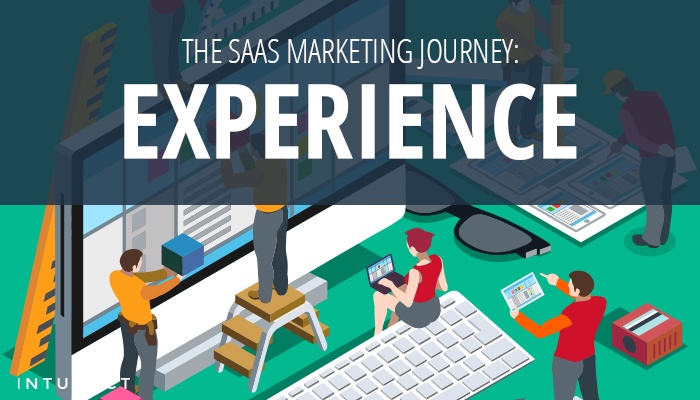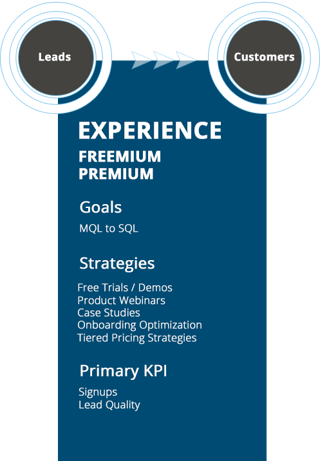
Thus far, we’ve reviewed the Attract and Convert phases of the SaaS Marketing Journey, which center on developing uninitiated consumers into promising leads. Subsequent entries will detail the entire process that ultimately results in loyal customers who actively promote your business for you, but now we’ll delve into the next step in your customer development journey, the Experience stage.
Experience the Product
 Up until this point, the SaaS Marketing Journey has closely resembled the traditional inbound methodology. The Experience phase, however, takes a step away from this prescribed thought process. It is at this point that marketing qualified leads (MQLs) progress into sales qualified leads (SQLs) that get to experience your product for the very first time, hopefully transforming them into paying customers.
Up until this point, the SaaS Marketing Journey has closely resembled the traditional inbound methodology. The Experience phase, however, takes a step away from this prescribed thought process. It is at this point that marketing qualified leads (MQLs) progress into sales qualified leads (SQLs) that get to experience your product for the very first time, hopefully transforming them into paying customers.
The Experience phase represents a fundamental difference between the SaaS Marketing Journey and that of traditional products where MQLs to SQLs is typically still characterized by pre-acquisition behavior. The introduction of Freemium and Premium offerings (which we talk about further below), allows potential customers to go beyond just reading about the product, to trying it out for themselves - before making a purchase decision. Later, we’ll discuss some strategies you can use to start them off.
Freemium Vs. Premium
In the Experience stage, the hands-on practice your leads receive in using your product ventures past the point of conversion and is broken down into two types of offers that are customarily featured as part of SaaS products: “Freemium” and “Premium.” The former has become increasingly popular as a way to entice customers by giving them unlimited access to a limited version of your product absolutely free of charge. Then these users ideally become promoters of your product, encouraging others to sign up and eventually securing a paid plan of their own as well. Meanwhile, premium offers typically begin with free trials and demos that give leads a taste of what your full product has to offer. Of course, this access is only available when a sale is made.
Individuals testing out Freemium and Premium products have each actively opted in to learn more about the value your product is expected to bring them as they test drive the product (or a version of the product) for themselves. These stages are an integral part of your SaaS marketing strategy.
While both Freemium and Premium product offers have their benefits, perhaps the most important part of the process is the customer onboarding experience. Thorough analysis and optimization is key to pinpointing a strategy that will allow your user to connect to your product on a personal level as quickly as possible, a response known as time-to-first-value or time-to-value (TTV). The sooner your user finds intrinsic value in your product, the more likely that they’ll convert to a customer.
It's also important to note that some Freemium users are just in it for the free version. They have no intention of ever upgrading. Optimizing your marketing strategy will help uncover these individuals as well as the true SQLs and help you increase conversions. Often times they are fantastic brand advocates, driving new signups, even if they aren't paying customers themselves.
The Strategies You Can Use
As stated above, the Experience stage sees your initial leads develop into marketing qualified leads and sales qualified leads on their way to becoming full-fledged customers. There are a number of ways to accomplish this transition, but the common element is that they place your prospects in the thick of your product, giving them hands-on experience of their own. Here are a few methods that could work:
- Free trials and demos: For Premium plans, offering a free trial or a demo of your product can often serve as an effective way of enticing prospects to engage in what you have to offer, setting the stage for an eventual sale. Here are some great resources to help you decide:
- Product webinars: Some prospects may not immediately take to your product or really even understand the value it offers. So oftentimes a webinar describing the problem your product solves is all it really takes to convert some prospects into loyal customers.
- Case studies: When a new product arrives on the scene, it’s common for prospects -- even those who have become targeted leads of your business -- to remain a bit skeptical of just how useful it really is. Crafting a detailed case study can help light the way towards new sales by explaining a situation in which your product made a real difference.
- Onboarding optimization: Convenience is one of the most important elements of any successful product, and if yours isn’t easy to sign up for, you’re likely to frustrate customers and miss out on tons of potential profits. Here are some great resources on optimizing our onboarding process:
- Tiered pricing strategies: Even if you have an amazing product on your side, not every prospect has the same ideal price point or even the same level of service they require from your product. So it’s a good idea to offer a number of options. For example, different subscription levels based on duration, additional features or other criteria might help assuage prospects who are on the fence. For pricing strategies we highly recommend these resources:
How to Measure Success
Because the end result of the Experience phase is conversion, this is perhaps one of the easiest parts of the SaaS Marketing Journey to determine success. Key performance indicators are number of sign-ups for either a Freemium or Premium version of your product (depending on what you offer) as well as the quality of leads.
By this point, a healthy funnel of your initial leads should be translated into sales qualified leads, but even if this is not the case, it certainly doesn’t mean that your efforts have gone to waste, as conversion can be a drawn-out process at times. In time, the leads you’ve converted into users will draw in other prospects that will help your product grow.
Here are some great tools to help measure your Experience Success:
Let's Bring It Back Around
The Experience stage may finally see those hard-earned leads develop into full-fledged customers, but the SaaS Marketing Journey is still far from complete. We can’t wait to share the rest of this invaluable journey with you and look forward to completing your road toward building a better business strategy to support your products. Stay tuned for more information, and brace yourself for moving forward in your SaaS business. Next up, Success.



